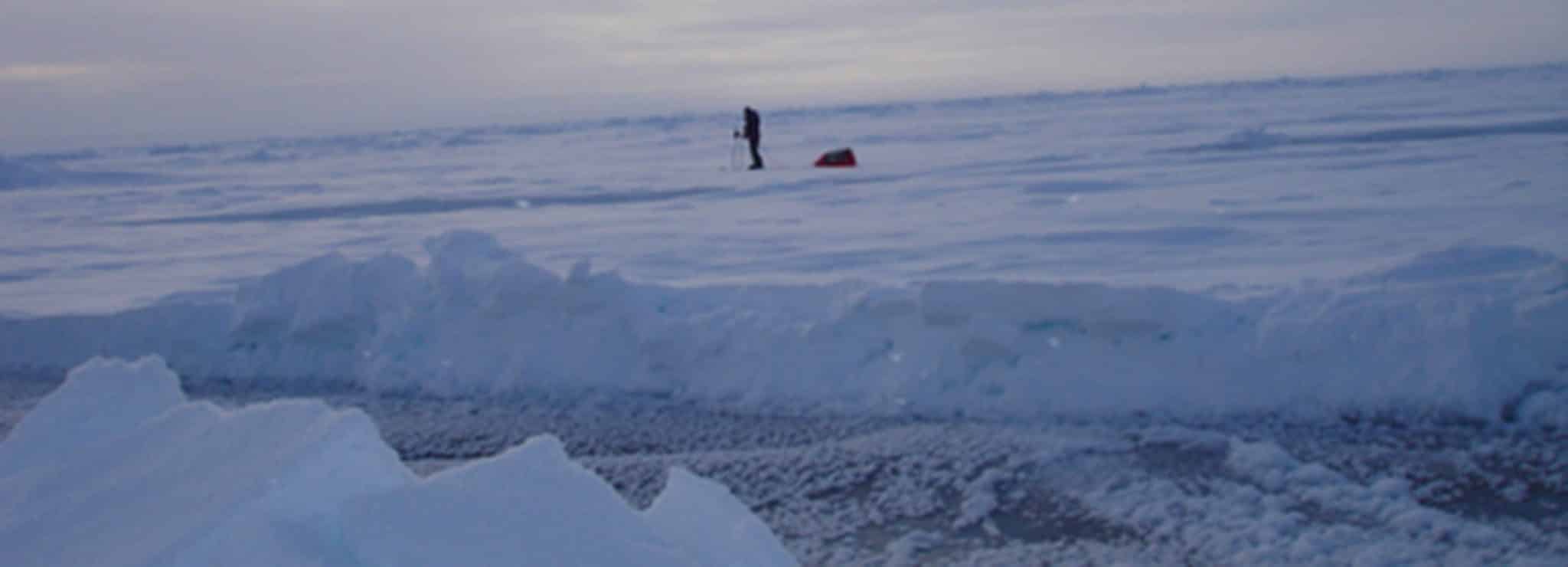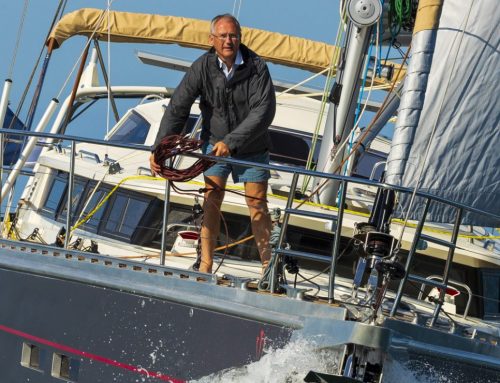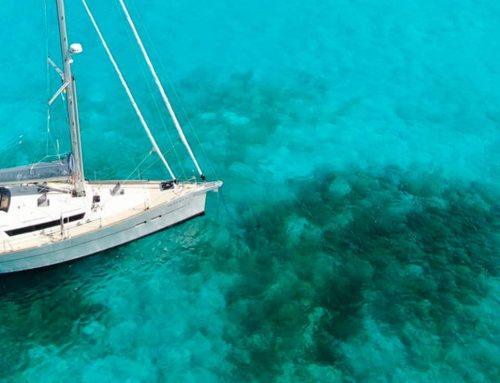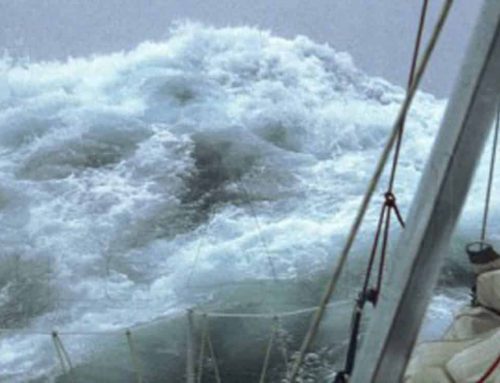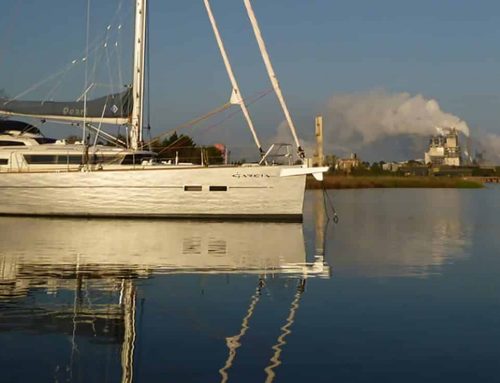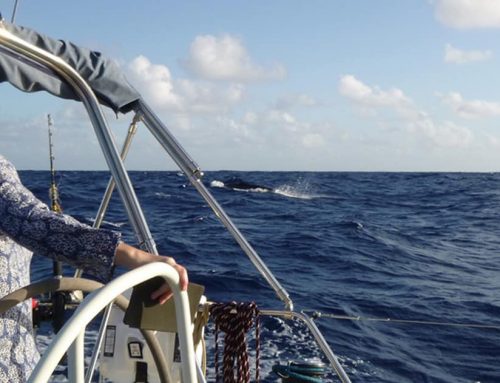This chronicle is the fourth of six written by British sailor, author and adventurer Pete Goss.
Find the page to all chronicles by clicking here: Long time cruising, a voyage of many highlights
Discover more about Pete Goss by visiting his official website.
British adventurer and sailor Pete Goss shares his experience after numerous expeditions he managed – and had success in – in remote areas and high latitudes, mainly in the Arctic zone. Although being 1997 ISAF World Sailor of the Year, Pete is not only a sailor but also a real all terrain adventurer, in Arctic zone for instance, as you can easly admit by reading this fourth paper of his chronicle he friendly accepted to write in exclusivity for Garcia Yachts.
I don’t quite remember when we decided to go to the North Pole but I do recall, like most good idea’s, that the notion presented itself from the bottom of a good bottle of red.
Alan Chambers and I had been planning an expedition to the South Pole for about a year when he was asked to guide a trip to the North Pole. First seen as a distraction it quickly morphed into an exciting opportunity when it struck us that I could go as his back up. This would be our first joint foray into a new and hostile environment without cost. Alan, a master in this line of challenge, would pass on as much knowledge as I could absorb. At the same time we could start to develop our approach to tackling the south pole by levering our newly discovered strengths and weakness’s as a team.

Pete Goss and Alan Chambers at North Pole © North Pole Challenge 2006
‘A hostile environment’ sounds so tame on paper but the reality is that daily life must carry on under a fair degree of duress. Hidden enemies lurk in the background waiting to creep up un-announced. Frost bite is always an issue and the worst thing about it is that as your flesh starts to freeze the nerves are gently cut off. This is where a buddy buddy system comes into its own as we continually check each other. Fortunately Alan spotted it creeping across my cheek and nose before severe damage could be done. Cold feet are something that you have to live with but can’t afford to ignore until numb enough to feel like stumps, for it can quickly become a prophetic sensation.
It’s also sobering to think that survival rests on a crust of frozen sea ice that is continually on the move and of varying thickness. There is nothing more unnerving than seeing the ice starting to flex and ripple away from under your ski’s. You can’t stop for that can be terminal and so you are left to rely on relaxed fluid movement. That and a fervent hope that thicker ice is ahead for there is no turning. Deep ocean currents compete with erratic wind driven surface movement to continually stress and tear the crust apart. I was shocked to put the tent up one night only to wake up fourteen miles away. It took two days of hard slog to end up just behind where had we started. I once remember the ice cracking in front of me and being surprised at Alans highly urgent and agitated shout from the other side. The speed at which it opened into a lead was shocking as I glanced back from my ungainly jump (Leads are linear cracks in the ice that form when ice floes diverge or shear) A relieved cup of tea later and it had become a large lake. Throw hungry Polar Bears into the mix and you have for a fun time.
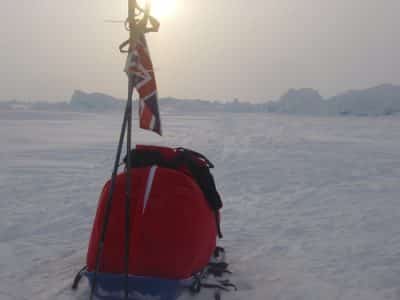
© North Pole Challenge 2006
It’s not all bad though, I returned to the North Pole many times for it has an alluring beauty that is unique. I had expected a cold and sterile world of white and so was amazed to find an ever changing landscape that was full of colour. Never have I seen so many hues of blue that constantly change with the passage of the sun. Differing ages of sea ice are reflected in the intensity of their colour and transparency, the oldest hard and beautiful enough to be mistaken for gem stones. As a lead opens in one place so the ice is compressed to erupt for the sky in another. There is never a dull moment and there is no room for complacency (but for danger).
Like some Phileas Fogg experience this is an alien world of no substance. With the closest land a mile beneath your feet it’s like being in suspension, space and time seem off kilter. The North Pole, the focus of all our toil is but the convergence of a mathematical model. The point at which our lines of longitude meet, it doesn’t physically exist. Reach it, have a cuppa and drift ice will have moved you on. Not far but enough to necessitate a short walk for celebratory pictures. Time takes on a new meaning for basic rhythms of night and day are robbed by perpetual daylight as a weak sun circles just above the horizon. This creates the illusion of standing in the centre of the worlds largest clock face where the passage of time is measured by marking lunch in Moscow, Paris and New York. There is something inescapably spiritual about this unique landscape which seems to touch the soul. Like the southern ocean I was drawn back to it and created a company with Alan with which we trained, equipped and lead groups of novices to the North Pole. Many of these wonderful people returned to their normal lives having had the time and space to make life changing decisions.
The North pole and a number of other expeditions changed my perception of remote latitudes which had always been painted as places of pain and little return. With the right equipment, knowledge and preparation I was heartened to find that there was a lot on offer. More dedication is required than throwing an anchor over the side in the Bahamas but the returns can be more rewarding. Not least for their uniqueness but also the satisfaction of being able to function and overcome a hostile environment. Rather than being relaxed by the balm of the tropics a testing experience heightens the senses to bring deeper, more meaningful and often longer lasting reward. The icing on the cake is that being in such an alien environment the full spectrum of senses are rewarded with unfamiliar colour, smell, noise, wildlife and culture.
Any ocean going vessel should be capable of delivering high latitudes. All the basic safety rules apply but a heightened sense of awareness and preparation are advised. Remote cruising is just that, remote. There is no convenient marina, hospital or shop to cover preparation shortfalls. There can be no gaps; take extra food, spares and a more sophisticated communications system. Have a detailed crisis plan written up and held by someone you trust back at home. Up your maintenance skills especially in the area of medicine. Think of the worst and be prepared with the best such as a Guy Cotten survival suit. Test those life jackets and drill the crew in their use so that details are instinctive and thought through. It’s no use having your knife in the wrong pocket when in a crisis.
Any ocean going vessel might be capable of taking you to high latitudes but that doesn’t mean that they are capable of gifting the hidden rewards. What’s the point of a shivering survival exercise when you could be warm, happy and equipped to see beyond the misery. A robust aluminium boat with watertight bulkheads lifts a huge amount of residual stress. Good insulation and heating makes for a cocoon in which to warm up and recover from mini expeditions. A robust rib with a reliable engine allows for the luxury of getting down with nature. A full bodied hull offers space for the extra stores and large tankage that remote sailing requires. The cockpit must be sheltered and having a pilothouse or a pilot saloon is a huge benefit for it nurtures an alert lookout and extends crew endurance.
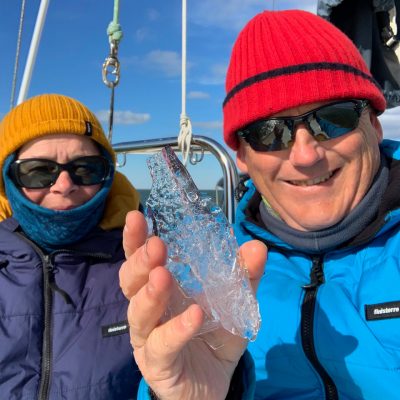
Ice for tea © Pete Goss
Clothing is very important as it needs to be a blend of specialist sailing and mountaineering equipment. Breathable materials come into their own with simple rugged design and construction being the name of the game. Added details like the addition of a braided zip extension makes all the difference when trying to zip up a jacket wearing mitts. I swear by Merino wool base layer garments followed by a water resistant mid layer for dryer days on deck. A bag of thermal hats never goes amiss along with neck warmers and ski goggles. Although waterproof clothing is a must the truth is that high pressure systems often mean that it is dry and so a good insulated jacket is preferable for much of the time. I love my faithful made by ‘Finisterre’ which has served me well for many a year and being designed for surfers its perfect for high latitude sailing. A hot water bottle makes a great companion on watch and in bed when trying to warm up.
Its the extremities that suffer so take another pair of boots that have insulated soles and are half a size too big. Make sure that you have excellent socks to fill the space. The boots must be generous about the calf for they need to accommodate the socks, first and mid layer thermals without compressing them. Take them with you and wear them when fitting for it’s too late when you dig them out in anger. Unlike many I don’t use insulated mugs for there is nothing like clasping a hot cuppa to warm cold fingers. I wear very thin first layer gloves, heavier thermal gloves and then generous mitts than can slip on and off easily. Never use winches with mitts on for they are prone to being dragged into the winch. Take them off and stuff them into your jacket pocket – which you have already made sure are big enough!
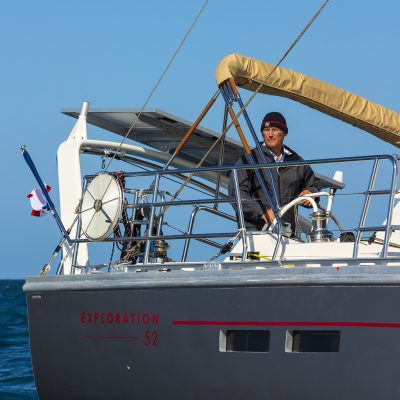
Pete Goss steering a Garcia Exploration 52 © J. Houyvet / Garcia Yachts
This more rugged and nuanced approach applies to the boat as well. Take long spiked poles to push away brash ice. A shallow draft is priceless for you can anchor in shallow water that rebuffs larger bits of ice as they run aground. Take larger fenders to smooth out commercial dockage that take the place of marina’s. I like to have a couple of large inflatable fenders to fill the increasing gap as you go forward and aft of midships. Carry extra long warps and plenty of chafe guard material, old fire hose is good if you can get it. Carry a couple of jerry cans so that fuel can be collected by dinghy. Bear protection in the form of a locally hired rifle is essential. Something that I would supplement with bear spray for who wants to hurt a bear in its natural habitat – we, after all, are the invading species.
That age old military maxim ‘Divide and Conquer’ should never be far from your mind. Make sure that the rib has a fully charged high quality water proof VHF with spare batteries. Contact with the mother vessel should be maintained with regular radio checks. A hand held GPS with spare batteries should not leave the boat until a waypoint has been added over the anchorage. If you can afford it take a hand held Satphone. Carry a written back up plan with a sketch of the chart with agreed RV’s in case of mishap. A waterproof grab bag should be in the dinghy in case it is cut off by sudden changes in weather or visibility and is forced to stay ashore for a prolonged period. Be very wary of being blown offshore if the outboard dies. Always have two people remain on board so that the mother ship isn’t passive through lack of manpower in an emergency. Search the web for others that have trodden the path before you for charts can be vague and there’s nothing like local knowledge and advice from the ground. Take a drone.
The detail that I allude too above must be applied to all areas of the expedition and imbedded within the crew through lots of meetings, training and delegation of responsibility. It is a lot to do so give each member an area that they can excel at and in so doing feel valued. I have always had crew moral and entertainment as a subject. This can range from a bag of chocolate in the cockpit to a weekly slap up meal to celebrate and reflect. There will be times when the boat can’t move so make sure you have books, games and ingredients for baking. Some people seem to elevate suffering into an end on its own when on expedition. This macho approach couldn’t be further from mine. Why not make it fun, fulfilling and come back both happier and fitter than when you left. After all isn’t that what life is about?
